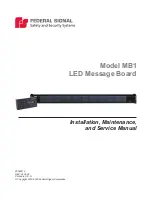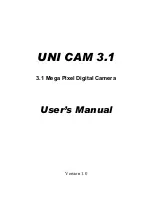
for each position. If the connector has fewer than 7 pins it should be centered on the display connector,
starting with Row 3 and Column 1 and going out. Any matrix style keypad will work with the display, as
well as momentary switches.
The diagram shows the logical layout (row 1, column 1 in upper left). The connector for the keypad is a
10 pin 0.1" spacing male header. Pins 1 through 5 are columns and pins 6 through 10 are rows. The keypad
is scanned whenever a key is pressed: there is no continuous key scan. This means that key presses are dealt
with immediately without any appreciable latency. This also prevents electrical noise which is often caused
by continuous key scans.
NOTE
The keypads may be laid out in a different pattern. If this is the case, the user will
need to interpret the key codes differently.
Table 6: Keypad Layout
Columns
Rows
1
2
3
4
1
’A’ 41 Hex
’F’ 46 Hex
’K’ 4A Hex
’P’ 50 Hex
2
’B’ 42 Hex
’G’ 47 Hex
’L’ 4B Hex
’Q’ 51 Hex
3
’C’ 43 Hex
’H’ 48 Hex
’M’ 4C Hex
’R’ 52 Hex
NOTE
The keypad connector must be wired with columns on one side and rows on the
other side of the center of the connector. In situations where the keypad isn’t wired this
way an adapter will need to be made, or the user should rewire the connector to meet this
requirement.
4.3 I
2
C Interface
The keypad is read by I
2
C master read. In short, this means that a read of the module will always return
the first unread key press. A read is initiated by writing to the module with its base address plus 1, then
clocking the module’s return byte after the module releases the SDA line. Much more detail on this basic
I
2
C function can be found in the I
2
C specification by Phillips. A good reference is also available at;
!"#%$ !&%'()*
The module contains a ten key press buffer so that it can be polled for key presses at an infrequent rate
(every 500 to 1000 mS is typical). All returned key presses indicate the presence or absence of additional
logged key presses by the most significant bit (MSB - bit 7). If the user has pressed two keys since the last
poll of the keypad interface, the first read will return the key code with bit 7 set and the second read will
return the key code with bit 7 clear. The application must take into account this bit to keep up with user key
presses. If there are no keypresses detected, the module will return zero (0x00).
Matrix Orbital
PK162-12
17
Содержание PK162-12
Страница 1: ...PK162 12 Technical Manual Revision 1 0...
















































